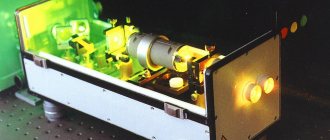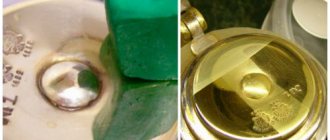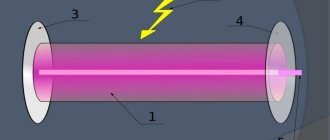Laser pointers have long been firmly established in our lives. They are used not only in schools and institutes, but also in training centers for future sailors, pilots and astronauts. After all, in order to show something on a board the size of a mini-golf course, you won’t be able to use any pointer other than a laser one.
Laser pointers are also used in military operations to give signals. Collimator sights operate on their basis. Everyone probably remembers action films and the red dot aimed at the victim’s forehead - this is a laser pointer-sight. Military pointers are customized to issue specific commands and resemble a laser projectile more than a pointer.
How does a laser pointer work?
The principle of operation of a laser pointer is as follows: an infrared LED generates a continuous beam with a wavelength of about 808 nanometers, which passes through the lens and hits a crystal of neodymium, yttrium and vanadium oxides. There it is converted into a beam with a wavelength of 1064 nanometers.
Laser pointers are used not only in everyday life, but also in military affairs
Then the beam passes through the next crystal - potassium-titanium-phosphorus. There, radiation invisible to the human eye is converted into a beam with a wavelength of 532-670 nanometers. Then, using an infrared filter and a lens that concentrates the radiation into a beam, a laser pointer beam emerges.
LU yellow color
Yellow light indicators are less common among others and have the following characteristics:
- beam length - 594 nm (one of the largest indicators);
- efficiency - less than 1% - the lowest in the class;
- service life - 2-4 years;
- operating principle: solid-state diodes;
- development - 2008.
Yellow pointer
Features of laser pointers
Many people have probably heard that shining a pointer into your eyes is unsafe. That’s right - if the beam of a laser pointer is directed frontally into the eye of a person or animal, then in a few seconds it will irreversibly damage individual cells of the retina. At the same time, you can shine the pointer on your skin or clothing as much as you want - nothing bad will happen. Remember:
- Laser pointers are designed for a long service life - up to 50,000 hours. Although, of course, cheap Chinese pointers break down very quickly. If you bought a laser miracle for pennies, do not expect that you will be able to use it for a long time. Children's disposable pointers in the form of keychains and flashlights can be used at school and for playing with a cat.
- If you need a good laser pointer for a long time, you need to buy one that has a battery and can be charged from the mains. Battery-powered pointers are considered less reliable, and rechargeable pointers can last 12 hours without interruption.
Lazer Beam Features
This pointer is really dangerous. Bursting balloons and lit matches are just “baby talk” for her. It is capable of starting a fire from a distance of 200 m, burning a mobile phone almost right through, starting a fire - any fabric (except specially treated) ignites instantly. Such lasers are used, for example, to demonstrate shows. At night, the beam is visible at a distance of 85 km. While the “range” of a conventional pointer barely exceeds 1 km.
There are no worthy analogues for such a toy in Russia yet. Local manufacturers offer only “household” pointers. Their power does not exceed 1,000 milliwatts. This is due, first of all, to the high cost of the emitting element - such a product would be uncompetitive on the market. Currently, a search is underway for a solution that would reduce costs.
The Myth of Laser Pointers
The main rumor about laser pointers is their effectiveness in fog. Alas, in fog, drizzling rain, snowfall or bright sunshine, a laser pointer is absolutely useless - the beam is not visible at all. But in classrooms, in dim and dark presentation halls, a laser pointer is capable of “piercing” a distance of up to 1.12 km.
This only applies to pointers with a red beam, which have a power of no more than 20 mW. Pointers with a green beam have a power of up to 1 W, and with a blue beam - up to 3 W. But they are considered too expensive for household use and are therefore used only for special needs.
Laser pointers are portable devices that contain emitters that generate waves of electromagnetic coherent and monochromatic origin in the visible range in beam form. The emitters can be laser diodes or full-fledged solid-state lasers.
LU purple color
See also the article Swiss knives and how to choose them
A special type of light pointer associated with the emergence of a new technology for digitizing Blu-ray media. Such pointers have the following functions:
- light beam length - 405 nm;
- commissioning date - 2008;
- service life - 3-5 years;
- Operating principle: high power solid state diodes.
Purple pointer
LU red color
These LUs are the cheapest and most common. They operate from a conventional button cell battery, based on red laser diodes with a radiation spectrum of 650-660 nm. They are equipped with driver boards that control power. To emit radiation in the form of a narrow beam, lenses convex on both sides, called collimators, are used.
Red LUs are mostly low-power up to 1-100 mW. Their characteristic feature is that the red diodes “burn out” quite quickly, reducing the intensity of the radiation, which is why most of these pointers, after a couple of months of operation, begin to shine worse, regardless of the battery charge.
Power, drivers, batteries and accumulators
The laser diode can only be powered directly from the battery at very low power. For diodes from 50 milliwatts, a specialized power supply is required. Its main function is voltage stabilization. Even a 0.1 volt change can dramatically reduce the life of a laser diode.
The type of power supply determines the power of the laser pointer. It is always done with a reserve of power. By the way, the power supply is one of the simplest and cheapest elements of the pointer. A typical option is a simple power driver on a round board across the body. Power supplies for LED flashlights or, conversely, boost converters, for example, for compact fluorescent lamps, are made in the same way. The batteries used are 18650, 16340, 32650. The batteries are regular AA, AAA, C and D. Hour batteries are often found in keychain pointers.
Green laser
During the day, the human eye is more sensitive to green colors than to red colors (about 6-10 times). Thanks to this, green laser shines more brightly. However, at night the opposite happens.
Green laser diodes are extremely expensive, so solid-state lasers with diodes are used to create green laser. They are not as expensive as green laser diodes, but more valuable than red ones. Green laser wavelength is 532 nm, with an efficiency of approximately 20%. Green LUs are more energy-consuming than red ones; as a result, it is difficult to select units powered by button batteries.
Typical models, form factors and power
The lower power limit of laser pointers is 1-5 milliwatts. The most powerful laser pointer is 10-20 watts. Laser pointers only come in three colors: red, blue and green. Sometimes there are yellow models, but they are very expensive, these are exotic products. As a middle option, there are also greenish-blue lasers. It is best to use green lasers – green laser. Their wavelength is as close as possible to the peak sensitivity of the human retina.
Based on green laser, there is a popular laser pointer for presentations in the form of a pen. There are models that are built into a regular handle. Great power is not required from such products; on the contrary, it will interfere and harm vision, making the light beam too bright.
LU: application
- LUs are often used by educational institutions, for example, for physics experiments, as well as for presentations;
- The point of light produced by the laser beam attracts the attention of pets. Cats and dogs react especially to them, which often leads people to play with these pets;
- Green LUs are used in both amateur and professional astronomical research. Green LUs are used to determine the directions of stars and constellations;
- LUs are used as laser target designators for precise aiming of firearms or pneumatic weapons;
- LUs are used by radio amateurs as a communication element within visible boundaries;
- Red LUs with disconnected collimators are used when creating amateur holographs;
- Laboratory practice uses LUs (especially green ones) to detect in liquids, gases or any transparent substances in small quantities impurities or suspensions of mechanical origin that are invisible to the naked eye.
Laser Safety
Laser radiation is dangerous if it comes into contact with the eyes.
Ordinary LUs have a power of 1-5 mW, they are classified as hazard classes 2-3A. They can be dangerous when the beam is directed into people's eyes for fairly long periods or using optical instruments. LUs with a power of 50-300 mW are classified as class 3B. They are dangerous because they cause severe damage to the retina of the eyes, even with short-term hits from a direct laser beam.
You should be aware that low power green DPSS pointers use significantly high power IR lasers which do not guarantee sufficient IR filtering. These types of radiation are invisible and, as a result, much more dangerous to the eyes of people and animals.
In addition, LUs can have extremely irritating effects. Especially if the beam hits the eyes of drivers or pilots, which can distract their attention or even lead to blindness. In some countries, such acts entail criminal liability. For example, in 2019, one American was sentenced to almost two years in prison for briefly blinding a pilot in a police helicopter with a powerful laser.
In recent years, there have been an increasing number of “laser incidents” in developed countries, caused by requirements to limit or prohibit drug use. Currently, New South Wales legislation provides for a fine for possession of medicinal drugs, and for committing a “laser attack” - imprisonment for up to 14 years.
The use of LU is prohibited according to the rules during football matches. For example, the Algerian Football Federation was fined 50,000 Swiss francs because fans used a laser pointer to blind the Russian national team goalkeeper Igor Akinfeev during the 2014 World Cup.
The most powerful laser pointer
Not long ago it became known about the appearance of the most powerful pocket laser, the “king” of the LU or the “Jedi sword”. The small, powerful laser can burn through thin plastics, explode children's balloons, set paper on fire, and blind people. The device from the Chinese manufacturer Wicked Lasers only superficially resembles popular LUs, but has a larger body.
Often, a laser pointer with a tiny cylinder that emits a red laser beam is used by children for games or for presentations at school. However, Wicked Lasers' new generation pointer will not be a toy for children. And this is no coincidence, because the output power of a Chinese laser pointer is tens and hundreds of times greater than that of conventional inexpensive laser pointers.
It is surprising that the Chinese “green supermodel” with a beam power of 0.3 watts reaches an “exposure range” of up to 193 kilometers.
A laser pointer is a portable device that contains an emitter that generates coherent and monochromatic electromagnetic waves in the visible range in the form of a beam. A laser diode (the design is much simpler) or a full-fledged solid-state laser (the design is more complex) can be used as an emitter.
There are several types of laser pointers, which differ in color and, accordingly, in the type of emitter:
- Reds
- Greens
- Blue
- Turquoise
- Blue
- Purple
- Yellow
- Orange
How does a laser pointer work?
Red laser pointers
The cheapest and therefore the most common. They operate on a regular button cell battery. This pointer operates on the basis of a red laser diode, the emission spectrum of which is 650-660 nm. In addition to the diode, the pointer has a driver board that controls the power. In order for the radiation to propagate in the form of a narrowly directed beam, a lens that is convex on both sides (or flat-convex, with the flat side facing the diode) is used. This lens is called a collimator. The power of red laser pointers is usually small and for most examples found on sale is 1-100 mW. An unpleasant feature of pointers based on red laser diodes is that these diodes quickly “burn out,” which leads to a decrease in radiation intensity. Therefore, any pointer of this type, after several months of use, shines much worse than a new one, regardless of the battery charge.
What opportunities does a powerful laser offer?
- Long distance alarm. A powerful laser can replace pyrotechnic signaling devices. It is especially effective in mountainous areas with good visibility from populated areas;
- Carrying out measurements over long distances. For example, a 10 W green laser pointer can measure the curvature of the earth's surface;
- Using a high-power laser as a light source for strobes and other entertainment devices. Optical attachments for dividing the beam, highlighting various figures and inscriptions are available in countless varieties. You can always find the most unexpected options in them;
- Laser shooting range with laser burning of balls. The device only works over a short distance;
- Laser fencing over long distances. Photo relays, homemade lidars, optical communication stations and other devices.
A powerful laser can illuminate clouds, which is an effective means of signaling. Under good circumstances, such a signal is even more noticeable than a flare. The devices operate high-power lasers in pulsed mode.
A separate direction is associated with the use of powerful laser decrees for engraving. Only the most powerful models over 10 W are suitable for this. Engraving is possible on soft materials, such as wood.











